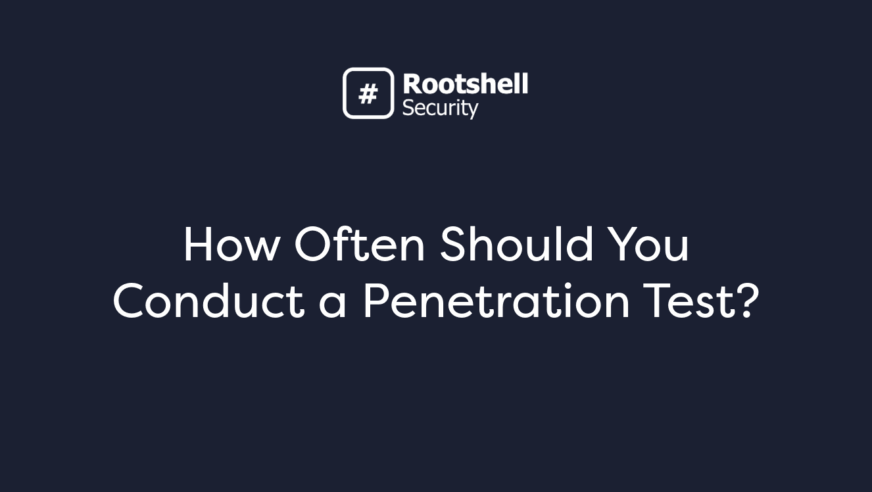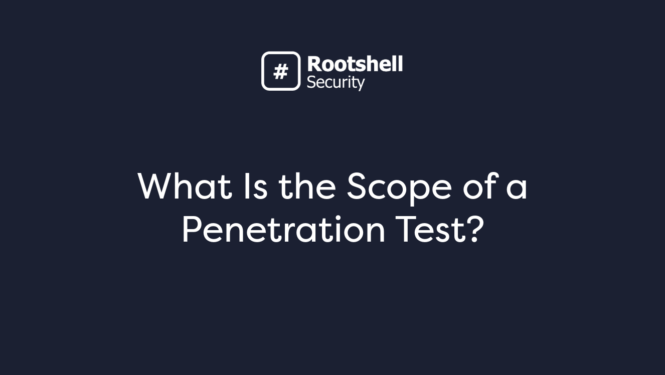Choosing the right type of penetration test to perform is important, but have you considered how often you should be conducting these tests? Determining how often these tests should be carried out is important to a strong and resilient cybersecurity approach. A 2025 DeepStrike report indicates that 12% of companies conduct penetration tests monthly, while 8% perform them daily, using automated tools.
The National Institute of Standards and Technology recommends that vulnerability scans be conducted at least monthly, as outlined in NIST Special Publication 800-53 Revision 5.
These findings highlight a clear gap: while some organizations take a proactive approach to security testing, many remain exposed due to infrequent assessments. In this blog, we’ll explore the factors that determine penetration testing frequency, the different testing intervals to consider, and best practices.
Why Should You Perform A Penetration Test?
Penetration testing, often referred to as pentesting, is a controlled simulation of a cyberattack on your systems, networks, or applications. Its purpose is to find vulnerabilities before malicious actors exploit them. Performing regular penetration tests helps organizations identify weaknesses that automated scans may overlook, such as complex configuration issues, logic flaws in applications, or subtle security gaps.
A lot of security breaches happen because a small vulnerability was overlooked. Regularly testing your systems means that you can reduce the risk of data breaches, protect customer information, and keep the trust of stakeholders.
Penetration testing also helps organizations meet regulatory requirements that mandate regular security assessments. Standards like PPCI DSS, ISO 27001, SOC 2, HIPAA, and NIST require companies to make sure that security controls function as intended. Beyond compliance, penetration testing provides insight into how attackers could exploit your systems. It helps to guide decisions on cybersecurity investments, patch management, and monitoring processes.
What Factors Determine How Often You Should Perform a Penetration Test?
The frequency of penetration testing depends on many factors, including the type of organization, the sensitivity of the data being protected, and how often your IT infrastructure changes.
Organizations that handle high-value or sensitive data face a greater risk of targeted attacks. These organizations typically require more frequent testing to protect customer information, proprietary data, and maintain regulatory compliance.
The frequency of performing a penetration test depends on several key factors. These factors ensure that the testing schedule aligns with the organization’s risk profile, compliance requirements, and the pace of change within its IT environment.
Here’s a detailed breakdown:
1. Regulatory and Compliance Requirements
Certain industries have mandatory penetration testing schedules. Examples:
- PCI DSS: Requires penetration tests after infrastructure changes.
- HIPAA: Requires regular security assessments to protect healthcare data.
- Compliance may dictate minimum frequency regardless of risk appetite.
2. Changes to Your Systems and Network
Major system or network changes trigger the need for a new test. Examples include:
- Deployment of new applications or servers
- Major software updates or infrastructure upgrades
- Migration to cloud services
Frequent changes increase the likelihood of introducing new vulnerabilities, so testing may need to be more frequent.
3. Emerging Threats
The changing nature of cyber threats affects testing frequency. If your organization is in a high-risk industry (e.g., finance, healthcare) or if there is an uptick in attacks relevant to your sector, you may need more frequent testing.
4. Organization Size and Complexity
Larger organizations with complex networks, multiple applications, and numerous endpoints require more regular testing. Smaller, less complex environments may be tested less frequently if changes are minimal.
5. Previous Security Findings
If prior penetration tests revealed serious vulnerabilities, follow-up tests may be scheduled sooner. Organizations with a history of security issues might adopt quarterly or biannual testing instead of annual testing.
6. Type of Penetration Test
The type of penetration testing also influences frequency:
- External assessments, which target internet-facing assets, may need to occur more often if the public attack surface is large or rapidly changing.
- Event-driven testing, conducted after security incidents, mergers, or significant changes, helps identify vulnerabilities introduced during transitional periods.
- Continuous penetration testing provides ongoing assessment and rapid feedback, especially useful for organizations with dynamic infrastructures or high threat exposure.
Testing Intervals to Consider
Determining how often to conduct penetration testing depends on your organization’s size, industry, and risk exposure.
While there’s no universal schedule, adopting a structured testing cadence ensures vulnerabilities are identified and addressed before they can be exploited. The following intervals outline common testing frequencies and the scenarios in which each is most effective.
Annual Testing
While some organisations still conduct annual penetration testing, relying solely on infrequent assessments can leave vulnerabilities undiscovered. Testing schedules should be driven by risk exposure and system changes, rather than a fixed interval. Regular, proactive testing ensures threats are detected and mitigated promptly.
Key Advantages:
- Provides a baseline assessment of security controls
- Ensures compliance with regulatory requirements (e.g., PCI DSS)
- Suitable for organizations with low to moderate risk profiles
- Cost-effective and easy to plan within annual budgets
- Helps track long-term security improvements
Limitations:
- Vulnerabilities that appear between tests may go unnoticed
- Limited responsiveness to rapidly emerging threats
- Provides only a snapshot rather than continuous insight
Biannual Testing
Biannual testing provides a balance between risk management and resource allocation.
Organizations with moderate risk profiles, such as growing technology firms or manufacturing companies, can detect vulnerabilities at regular intervals while controlling costs. This schedule allows time for remediation and strategic improvements between tests.
Key Advantages:
- Balances risk management with cost efficiency
- Detects vulnerabilities at regular intervals
- Allows time for remediation and strategic planning
- Suitable for organizations with moderate risk profiles
Limitations:
- Vulnerabilities may still appear between tests
- It may be too infrequent for changing IT environments
- Not ideal for high-risk or highly dynamic systems
Quarterly Testing
Quarterly testing is recommended for high-risk organizations, including financial institutions, healthcare providers, government agencies, and high-volume e-commerce platforms.
Frequent assessments detect vulnerabilities arising from constant infrastructure updates, application changes, or regulatory requirements. Quarterly testing supports ongoing security improvements and reduces exposure to fast-moving cyber threats.
Key Advantages:
- Detects vulnerabilities from frequent system or application changes
- Supports regulatory compliance
- Reduces exposure to fast-moving cyber threats
- Promotes continuous security improvement
Limitations:
- Requires more resources and budget than annual/biannual testing
- May create operational overhead if not properly managed
- Can require dedicated security personnel or external providers
Event-Driven Testing
Event-driven testing occurs in response to major infrastructure updates, security incidents, or mergers. These assessments ensure that changes in systems, business processes, or organizational structure do not introduce vulnerabilities.
Event-driven testing complements scheduled assessments, providing a flexible method to address risks.
Key Advantages:
- Provides flexible, targeted testing when changes occur
- Ensures new updates or incidents don’t introduce vulnerabilities
- Complements scheduled assessments for broad risk coverage
- Addresses risks during transitional periods
Limitations:
- Does not provide regular ongoing assessment
- Relies on trigger events, so some vulnerabilities may go unnoticed
- Requires quick coordination, which can be challenging
Continuous Testing
Continuous penetration testing has emerged as a preferred approach for organizations with dynamic IT systems, high-value assets, or frequent software releases. PTaaS platforms allow for automated or scheduled testing of applications, networks, and systems, providing real-time insights into vulnerabilities.
Continuous assessments enable rapid response to new threats, integration with agile development cycles, and a proactive approach to maintaining security posture.
Key Advantages:
- Offers real-time visibility into vulnerabilities
- Supports IT environments and frequent releases
- Integrates with development cycles
- Enables quick response to threats
- Promotes a proactive, always-on security posture
Limitations:
- Higher implementation and operational costs
- Requires technical expertise or managed PTaaS providers
- Can produce alert fatigue if not properly managed
- It may be overkill for low-risk or static environments
What are Penetration Testing Best Practices?
Penetration testing is most effective when conducted systematically and thoughtfully. Following best practices ensures that tests not only identify vulnerabilities but also provide actionable insights to strengthen your organization’s overall security posture.
Define Clear Objectives and Scope
Establish what you want to achieve: identify vulnerabilities, test incident response, or comply with regulations. Clearly define the scope of testing, including systems, applications, networks, and cloud environments, to avoid unintended disruptions.
Use Skilled and Certified Testers
Engage experienced professionals or certified testers (e.g., OSCP, CEH, CREST). Ensure testers know to simulate realistic attack scenarios without causing harm to live systems.
Combine Automated Tools and Manual Testing
Automated scanning can quickly identify known vulnerabilities. Manual testing uncovers logic flaws, complex misconfigurations, and subtle security gaps that tools may miss.
Test Regularly and After Major Changes
Conduct tests at regular intervals based on risk level. Perform event-driven testing after system upgrades, application deployments, or infrastructure changes.
Simulate Realistic Attack Scenarios
Consider approaches like red team exercises to mimic real-world attacks. Test not only systems but also detection, response, and mitigation processes.
Document Findings Clearly and Prioritize Risks
Provide a vulnerability management report that outlines vulnerabilities, risk levels, and recommended remediation steps. Prioritize issues based on impact and exploitability, so critical vulnerabilities are addressed first.
Coordinate With Stakeholders
Inform IT, security, and management teams of the test schedule and scope. Make sure incident response teams are aware to avoid confusion during testing.
Maintain Compliance and Legal Requirements
Confirm testing activities comply with regulatory frameworks (e.g., PCI DSS, ISO 27001, HIPAA). Make sure proper authorization is in place to avoid legal or contractual issues.
Retest After Remediation
Once vulnerabilities are addressed, verify fixes through retesting to ensure issues are fully resolved.
Learn and Improve Continuously
Use findings to strengthen security posture and update policies, procedures, and training. Incorporate lessons learned into future pentesting cycles and incident response planning.
Regular Penetration Testing with Rootshell Security
Regular penetration testing is important to keeping your organization’s cybersecurity strong and resilient.
At Rootshell Security, we combine expert knowledge with the latest testing methodologies to identify vulnerabilities before they can be exploited, helping you reduce the risk of avoidable security breaches.
To learn more about our penetration testing services and full range of cybersecurity solutions, get in touch with the experts at Rootshell Security today.



